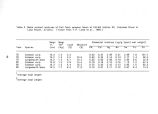| OCR Text |
Show standards for recreational activities are presently maintained in Lake Powell, but growth of recreational use has led to increased bacterial levels at high- use beaches. Another aspect of this problem requiring clarification is the source( s) of the fecal pollution and its longevity in beach waters and sediments. Possible sources include illegal discharges from vehicles and watercraft on a beach; people's bodies; defecation by humans on shoreline areas subsequently inundated by rising lake waters; pets; or runoff from upslope areas around camps where further human defecation occurs. At some sites the source of fecal pollution may be cattle or wildlife. Fitzgerald et al. ( 1985) found that 48 percent of the streptococcal samples on which bacterial speciation was performed were dominated by Streptococcus species originating from livestock or wildlife. A better understanding of pollutant origins clearly is needed to develop effective mitigative measures. III. D. 2. Management alternatives. Alternative A: No action This alternative would continue the present system of monitoring water quality through special- funding projects every five to ten years. Its disadvantage lies in the possibility that a monitoring project may not be funded at the time it is needed. Also, because investigators frequently use different techniques, results between studies would continue to be difficult to compare. The risk of not detecting unhealthful water quality conditions is relatively great under this alternative and could result in more cases of gastroenteritis among park visitors. Alternative B: Establish a regular monitoring program ( preferred alternative) This alternative would enable the NRA to closely monitor bacterial levels in beach waters and identify potential health problems before they occur. Compliance with legal standards would be enhanced. A monitoring plan would be designed specifically for the NRA, outlining sites, sampling methods and schedules, and analytical methods. The monitoring could be conducted by NPS staff, state officials, or by contract to a professional laboratory, but would be funded to occur on a regular basis. The monitoring not only would identify problem areas, but also would help identify pollution sources by allowing a direct comparison of the dominant uses of contaminated sites with clean sites. 30 |








































































































